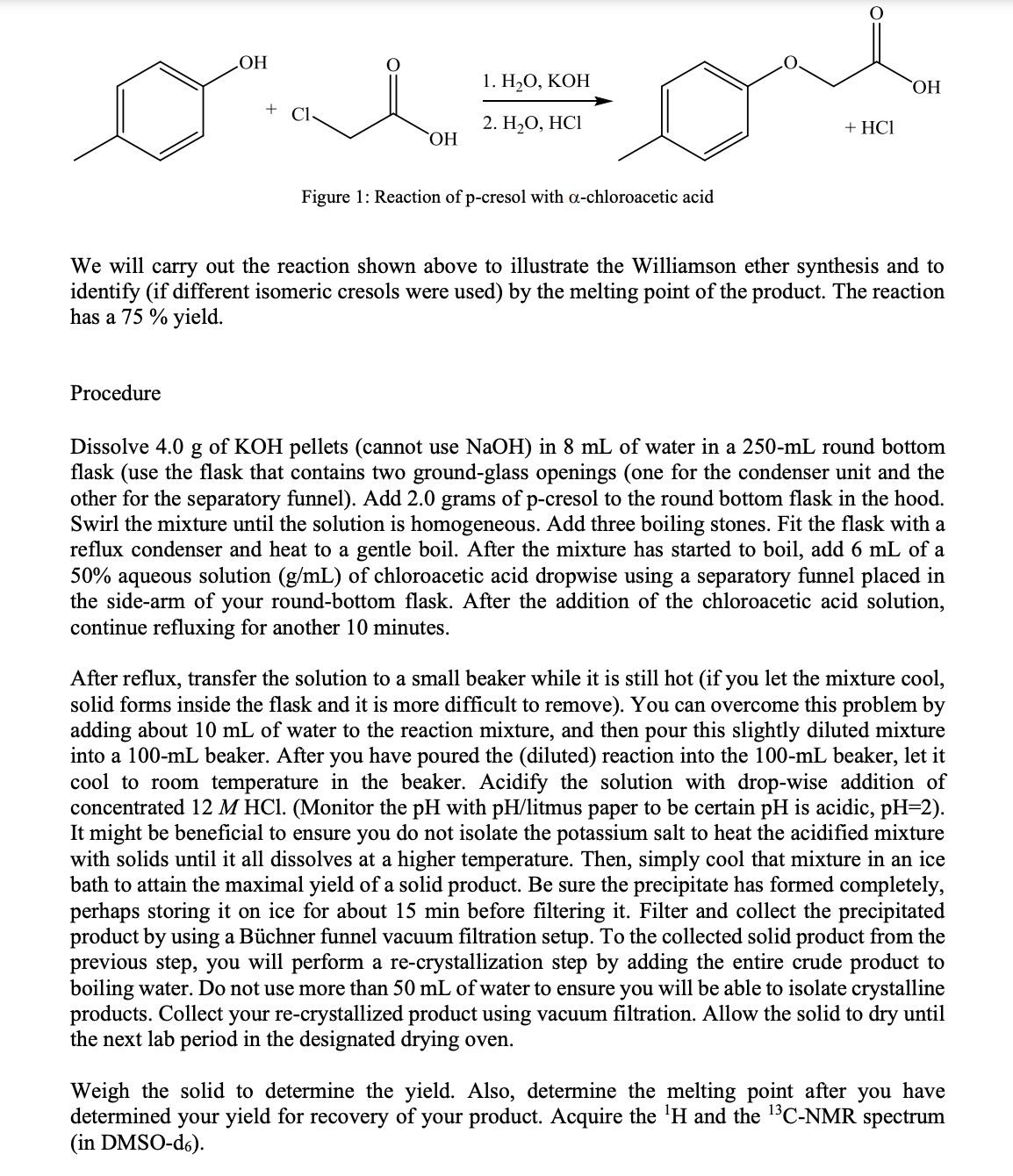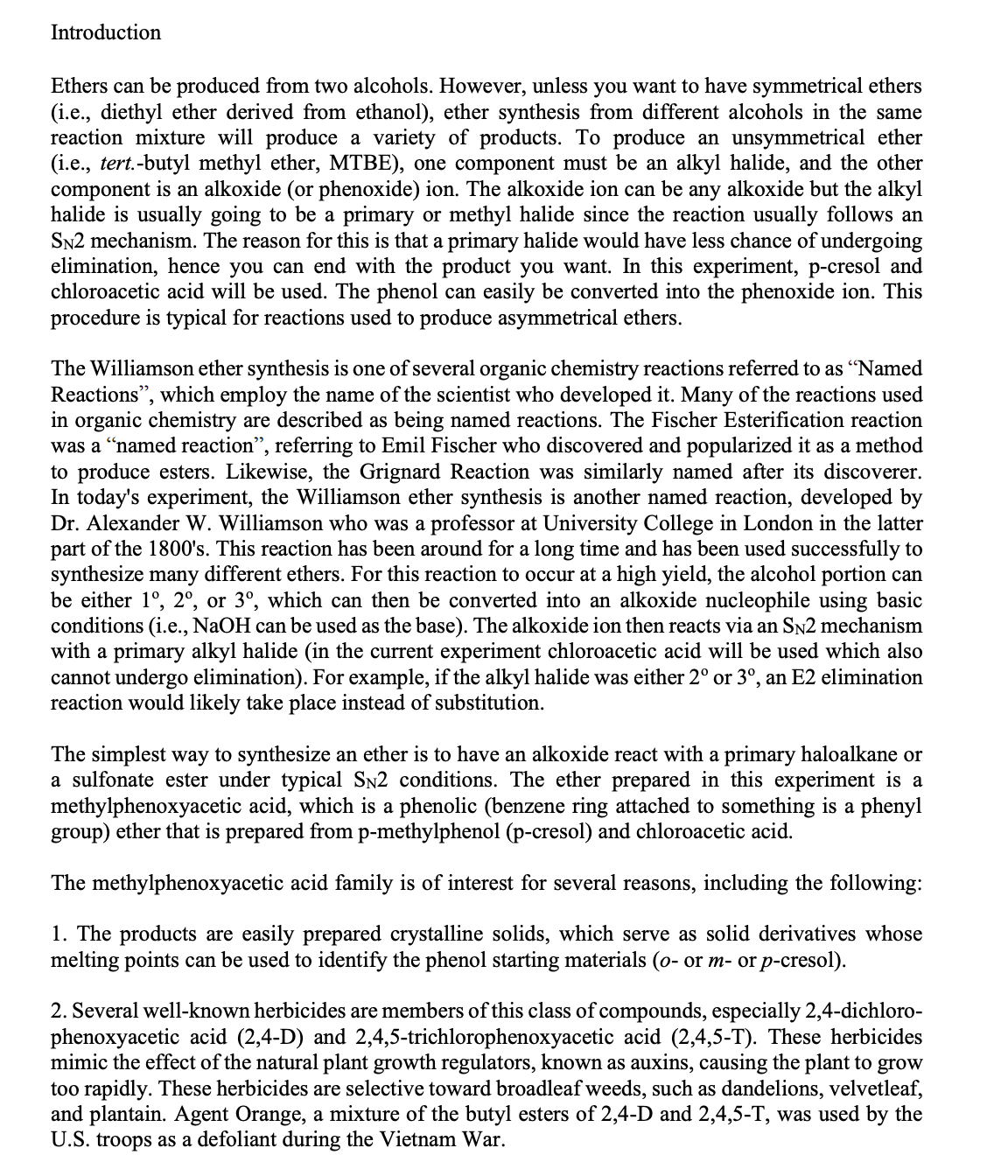Organic Chemistry
8th Edition
ISBN:9781305580350
Author:William H. Brown, Brent L. Iverson, Eric Anslyn, Christopher S. Foote
Publisher:William H. Brown, Brent L. Iverson, Eric Anslyn, Christopher S. Foote
Chapter16: Aldehydes And Ketones
Section: Chapter Questions
Problem 16.63P
Related questions
Question
the background for the experiment (=mechanism)
2 paragraphs

Transcribed Image Text:НО
1. Н,О, КОН
+
2. Н,О, НСІ
+ HCІ
HO,
Figure 1: Reaction of p-cresol with a-chloroacetic acid
We will carry out the reaction shown above to illustrate the Williamson ether synthesis and to
identify (if different isomeric cresols were used) by the melting point of the product. The reaction
has a 75 % yield.
Procedure
Dissolve 4.0
g
of KOH pellets (cannot use NaOH) in 8 mL of water in a 250-mL round bottom
flask (use the flask that contains two ground-glass openings (one for the condenser unit and the
other for the separatory funnel). Add 2.0 grams of p-cresol to the round bottom flask in the hood.
Swirl the mixture until the solution is homogeneous. Add three boiling stones. Fit the flask with a
reflux condenser and heat to a gentle boil. After the mixture has started to boil, add 6 mL of a
50% aqueous solution (g/mL) of chloroacetic acid dropwise using a separatory funnel placed in
the side-arm of your round-bottom flask. After the addition of the chloroacetic acid solution,
continue refluxing for another 10 minutes.
After reflux, transfer the solution to a small beaker while it is still hot (if you let the mixture cool,
solid forms inside the flask and it is more difficult to remove). You can overcome this problem by
adding about 10 mL of water to the reaction mixture, and then pour this slightly diluted mixture
into a 100-mL beaker. After you have poured the (diluted) reaction into the 100-mL beaker, let it
cool to room temperature in the beaker. Acidify the solution with drop-wise addition of
concentrated 12 M HCI. (Monitor the pH with pH/litmus paper to be certain pH is acidic, pH=2).
It might be beneficial to ensure you do not isolate the potassium salt to heat the acidified mixture
with solids until it all dissolves at a higher temperature. Then, simply cool that mixture in an ice
bath to attain the maximal yield of a solid product. Be sure the precipitate has formed completely,
perhaps storing it on ice for about 15 min before filtering it. Filter and collect the precipitated
product by using a Büchner funnel vacuum filtration setup. To the collected solid product from the
previous step, you will perform a re-crystallization step by adding the entire crude product to
boiling water. Do not use more than 50 mL of water to ensure you will be able to isolate crystalline
products. Collect your re-crystallized product using vacuum filtration. Allow the solid to dry until
the next lab period in the designated drying oven.
Weigh the solid to determine the yield. Also, determine the melting point after you have
determined your yield for recovery of your product. Acquire the 'H and the 1C-NMR spectrum
(in DMSO-ds).

Transcribed Image Text:Introduction
Ethers can be produced from two alcohols. However, unless you want to have symmetrical ethers
(i.e., diethyl ether derived from ethanol), ether synthesis from different alcohols in the same
reaction mixture will produce a variety of products. To produce an unsymmetrical ether
(i.e., tert.-butyl methyl ether, MTBE), one component must be an alkyl halide, and the other
component is an alkoxide (or phenoxide) ion. The alkoxide ion can be any alkoxide but the alkyl
halide is usually going to be a primary or methyl halide since the reaction usually follows an
SN2 mechanism. The reason for this is that a primary halide would have less chance of undergoing
elimination, hence you can end with the product you want. In this experiment, p-cresol and
chloroacetic acid will be used. The phenol can easily be converted into the phenoxide ion. This
procedure is typical for reactions used to produce asymmetrical ethers.
The Williamson ether synthesis is one of several organic chemistry reactions referred to as "Named
Reactions", which employ the name of the scientist who developed it. Many of the reactions used
in organic chemistry are described as being named reactions. The Fischer Esterification reaction
was a "named reaction", referring to Emil Fischer who discovered and popularized it as a method
to produce esters. Likewise, the Grignard Reaction was similarly named after its discoverer.
In today's experiment, the Williamson ether synthesis is another named reaction, developed by
Dr. Alexander W. Williamson who was a professor at University College in London in the latter
part of the 1800's. This reaction has been around for a long time and has been used successfully to
synthesize many different ethers. For this reaction to occur at a high yield, the alcohol portion can
be either 1°, 2°, or 3º, which can then be converted into an alkoxide nucleophile using basic
conditions (i.e., NaOH can be used as the base). The alkoxide ion then reacts via an SN2 mechanism
with a primary alkyl halide (in the current experiment chloroacetic acid will be used which also
cannot undergo elimination). For example, if the alkyl halide was either 2° or 3°, an E2 elimination
reaction would likely take place instead of substitution.
The simplest way to synthesize an ether is to have an alkoxide react with a primary haloalkane or
a sulfonate ester under typical Sn2 conditions. The ether prepared in this experiment is a
methylphenoxyacetic acid, which is a phenolic (benzene ring attached to something is a phenyl
group) ether that is prepared from p-methylphenol (p-cresol) and chloroacetic acid.
The methylphenoxyacetic acid family is of interest for several reasons, including the following:
1. The products are easily prepared crystalline solids, which serve as solid derivatives whose
melting points can be used to identify the phenol starting materials (o- or m- or p-cresol).
2. Several well-known herbicides are members of this class of compounds, especially 2,4-dichloro-
phenoxyacetic acid (2,4-D) and 2,4,5-trichlorophenoxyacetic acid (2,4,5-T). These herbicides
mimic the effect of the natural plant growth regulators, known as auxins, causing the plant to grow
too rapidly. These herbicides are selective toward broadleaf weeds, such as dandelions, velvetleaf,
and plantain. Agent Orange, a mixture of the butyl esters of 2,4-D and 2,4,5-T, was used by the
U.S. troops as a defoliant during the Vietnam War.
Expert Solution
This question has been solved!
Explore an expertly crafted, step-by-step solution for a thorough understanding of key concepts.
This is a popular solution!
Trending now
This is a popular solution!
Step by step
Solved in 2 steps with 1 images

Recommended textbooks for you

Organic Chemistry
Chemistry
ISBN:
9781305580350
Author:
William H. Brown, Brent L. Iverson, Eric Anslyn, Christopher S. Foote
Publisher:
Cengage Learning


Organic Chemistry: A Guided Inquiry
Chemistry
ISBN:
9780618974122
Author:
Andrei Straumanis
Publisher:
Cengage Learning

Organic Chemistry
Chemistry
ISBN:
9781305580350
Author:
William H. Brown, Brent L. Iverson, Eric Anslyn, Christopher S. Foote
Publisher:
Cengage Learning


Organic Chemistry: A Guided Inquiry
Chemistry
ISBN:
9780618974122
Author:
Andrei Straumanis
Publisher:
Cengage Learning